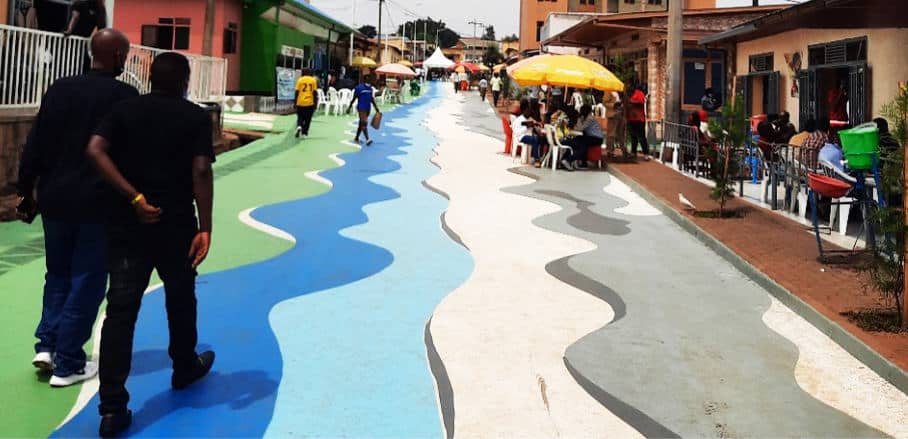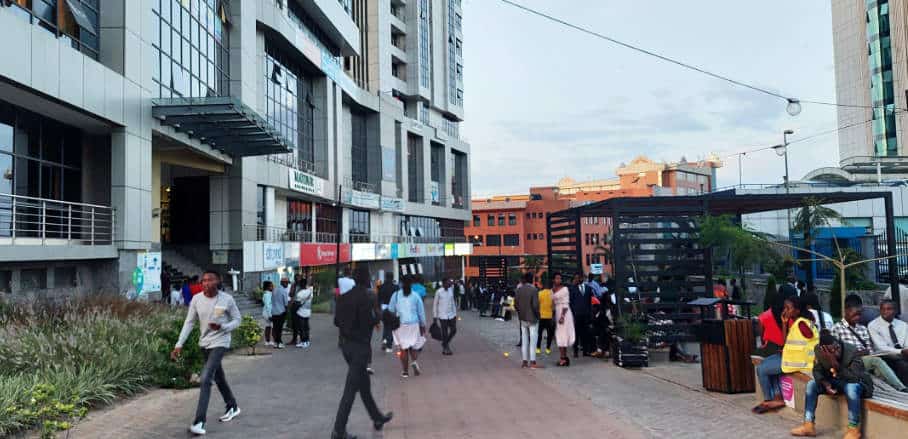(Re)thinking Car-Free Urban Spaces: Kigali’s Imbuga City Walk
We have adapted to living in cities surrounded by cars and asphalt. Josephine Malonza argues on the need to rethink city life and takes us on a stroll along the Imbuga City Walk in Kigali.
The car-free movement gains momentum in many cities around the world, especially in a world post-COVID. During the first few months of the pandemic, empty streets contributed to a rethinking of cities and urban life. This further inspired a deeper reflection of the long-existing concern that cities tend to merely marginally expand their public open spaces despite the overwhelming expansion of the built environment.
New Priorities – Streets Become Communal Spaces
Who would have imagined that possibilities would open up for streets to become ‘social spaces’? That streets would transform into public spaces where pedestrians are the priority in contrast to the otherwise vehicular streets, where cars always come first? Indeed, streets all over the world are important symbols of the public realm, as they constitute a significant part of open public space. Since streets primarily provide for human activities, they are potentially able to cater for the functional, social, and recreational needs of people. From this perspective, they are increasingly and positively associated with economic growth, people’s physical health, and a sense of community.
Even on a global scale, the multiple benefits of pedestrianised streets within urban areas include improved safety, social cohesion, lower carbon emissions, less air pollution, and fewer road traffic accidents, to name only a few. In higher-income countries, the COVID-19 pandemic arguably forced governments to act fast in terms of securing more space for people to walk and cycle, and some of these changes will probably be irreversible. Pedestrianisation in these countries, even before the pandemic, seems to follow a similar pattern of ‘stick and carrot’ as they contribute to making cycling and walking safer and more pleasant while making driving more difficult. In lower-income countries, however, the empty streets gave newer inspirations and reflections for pedestrianising parts of urban and neighbourhood streets into public spaces.
Pedestrianisation Within Rwanda’s War Against the Concrete Jungle
Rwanda is not an exception. By pedestrianising several streets in Kigali, and more similar pipeline projects in secondary cities, Rwanda is setting a precedent on the war against the ‘asphalt and concrete jungle’ that is attacking cities in this era of rapid urbanisation within the wider context of the African continent. Residents of Kigali and secondary cities can freely go to the pedestrianised city streets to meet and spend time with their friends, look and walk around, window-shop, and relax.
Within the last two years alone, Kigali, Rwanda’s capital, has implemented various projects towards a more pedestrian and cycling-friendly cityscape. Next to the Imbuga City Walk, located in the central business district, the Biryogo green tea corridor located in the oldest and most vibrant neighbourhood of Kigali enjoys great popularity not least because of its complementing streets for children and car-free zone on the weekends located in the most densely populated residential neighbourhood of Kigali. Besides the physical locations described above, Rwanda has also adopted car-free days twice a month and periodic night runs, further morphing streets into 24-hour urban public spaces that significantly contribute to improving conviviality in cities.

Streets become social spaces – the Imbuga City Walk in Kigali. © Josephine Malonza
The Imbuga City Walk – Transforming Kigali’s Central Business District
The Imbuga City Walk is a car-free zone in Kigali’s central business district that was transformed into ‘a recreational and green space’, whose implementation was completed in December 2021. The project is characterised by pedestrian and cycling-friendly pavements, green corridor landscaping, kiosks for food and other items, an exhibition space, and a playground. Several support facilities such as street benches, free WiFi, a city lounge, an arcade, pedestrian-friendly street lamps, and public lavatories will complete the City Walk.
However, next to the aforementioned advantages, equitable access to cities can be considered the biggest accomplishment of car-free zones. It can be observed that the Imbuga City Walk is attracting more people from more varied backgrounds than it did previously. Visitors from different economic levels are drawn to the common space, which makes everybody feel welcome. Families are using the space, especially on the weekends, and considering the absence of vehicular traffic, various differently-abled people use it as a safe space.
Promoting Car-Free Cities as New Spaces of Togetherness
This development is especially valuable since the more vulnerable members of society – low-income people (without cars), people living with disabilities, children and women – suffer most from traffic-related challenges in cities, be it the harmful effects of air pollution or the numbers of people hurt or killed in vehicle accidents. Considering that cars are always a good starting point in cutting down air pollution or carbon emissions, pedestrianisation is an excellent tool for environmentalists in pushing strategies for green cities as well. From a socio-cultural perspective, it is assumed that ‘cars are never just cars’ but seem to be deeply interwoven into our culture and consumption.
Cars are arguably also seen as symbols of affluence, independence, and success, and as such, a lot of young people growing up through education and transitioning into employment are aspiring to buy a car (the bigger the better) in order to convey an image of success. This big but also unrealistic dream only diverts attention from the multiple problems that cars within cities evoke: poor air quality, unsafe streets, car reliance and carbon emissions.
Therefore, the process of converting cities at least partly into car-free spaces hopefully will be transformational and irreversible, especially in encouraging us to rethink the entire basis of city life as social rather than economic togetherness.
- (Re)thinking Car-Free Urban Spaces: Kigali’s Imbuga City Walk - 27. October 2022
